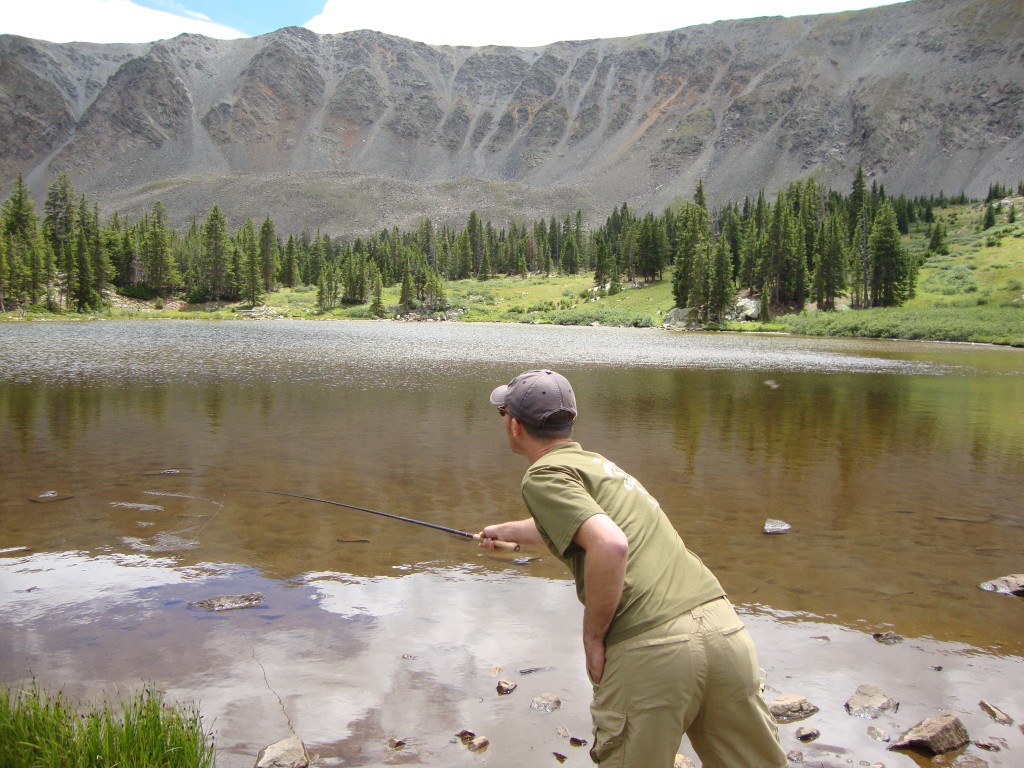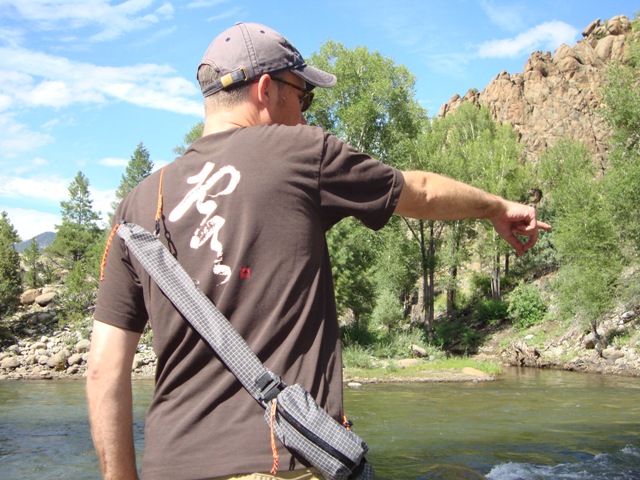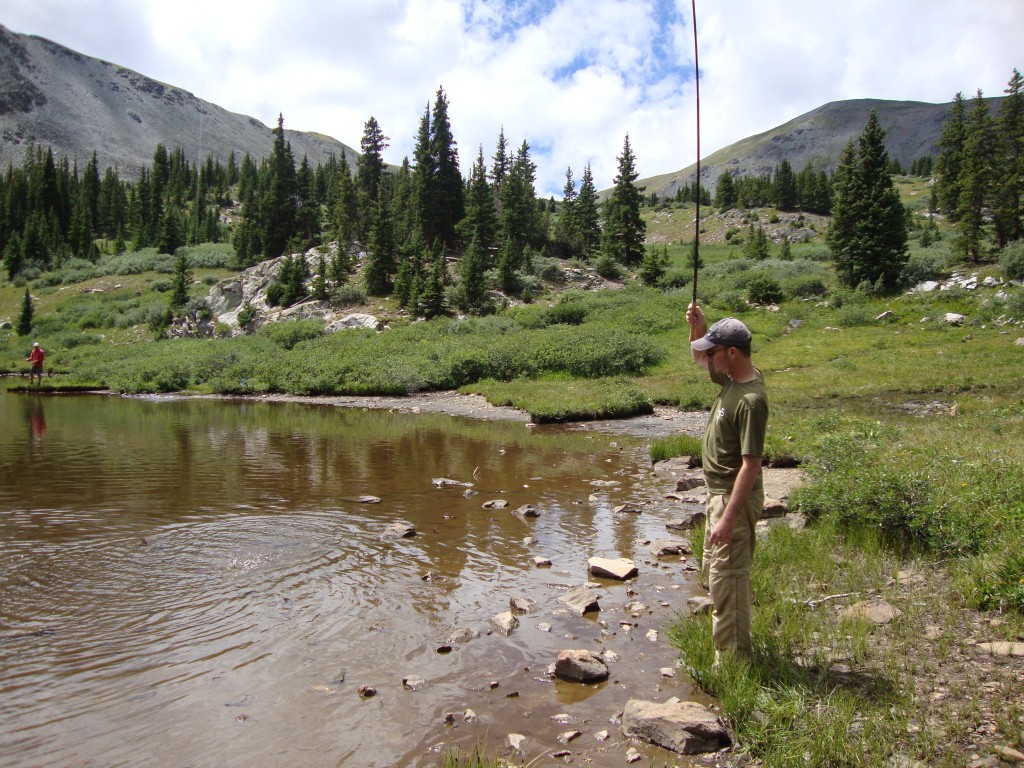[/caption]
While Tenkara fishing is often pigeonholed as being only for small streams, I’ve recently fallen in love with Tenkara fishing in lakes. Just as the lack of a reel and the ability to shoot line force you to change your technique on rivers, so too does Tenkara force you to adapt your method in stillwaters–posing a fun challenge for fly fishers looking to put their skills to the test. Here are some observations I’ve made when fishing lakes with Tenkara fly rods.
Gear for Tenkara Lake Fishing
In my opinion, the Tenkara USA Amago is the best choice of rod for lake fishing. The 13’ 6” length extends your reach considerably (especially if you’re not wading) and I find the action to be just right for throwing small flies with a long, fine tippet. I have had the most success with #20 or smaller midge patterns on a 6X or 7X tippet. My favorite pattern is a #22 Griffith’s Gnat with a pearlescent Flashabou tag. A close second is a #20 or #22 Blue Winged Olive Comparadun. Using a Tenkara USA standard 10’ 6” fly line, I typically attach a 5 ft. tippet. This not only gives you a ittle more distance but also delivers a gentler landing to spooky fish.
Tenkara Lake Fishing Strategy
 Other than the fact that you can’t boom out a 60 ft. cast, Tenkara lake fishing isn’t that different than stillwater fishing with a conventional fly rod. All of the lake fishing I do is in small to medium size lakes where I can sight fish so what I’m about to describe wouldn’t apply if you’re blind fishing in Lake Michigan (for example).
Other than the fact that you can’t boom out a 60 ft. cast, Tenkara lake fishing isn’t that different than stillwater fishing with a conventional fly rod. All of the lake fishing I do is in small to medium size lakes where I can sight fish so what I’m about to describe wouldn’t apply if you’re blind fishing in Lake Michigan (for example).
People new to fly fishing in lakes often make a common mistake: they move too much. Changing spots makes sense in streams, but in lakes, it rarely does. In fact, it’s usually the opposite: when lake fishing, the fish move–you shouldn’t. Unlike fish in streams that tend to stay put in a good holding spot (forcing the angler to move), lake fish cruise. They’re constantly on the move looking for food, mates, or a place to hide from predators. In other words, the fish come to you (if your patient enough).
I typically stand in one spot and wait for cruising fish to swim near shore. Then, I predict their trajectory and cast my fly 4 or 5 feet ahead of them (where I think they’ll be in a few seconds). If I’ve calculated correctly, they’ll intersect with my fly and (hopefully) take. If they don’t, I make a second “Hail Mary” cast right on their nose while they’re swimming away. Sometimes, the impact of a fly hitting the water triggers an instinctual response to grab a potential meal before another trout gets it. In this case, they have less time to inspect the fly and if it looks buggy enough, they’ll take it out of sheer competitiveness. If that doesn’t work–no worries. I simply wait for the next fish or pod of fish to come cruising along. Anyone who has ever bonefished will know what I’m talking about. Instead of relentlessly casting, you wait, and only cast when you see the opportunity. It’s more like hunting than fishing.
Those are my experiences with Tenkara lake fishing. What are yours?










Jason, great advice here: I typically stand in one spot and wait for cruising fish to swim near shore.
Lake fishing w/Tenkara requires patience (and patience), and I find it very rewarding. Then, when you’ve dialed it in and the fishing is good, it can be as fast, and as fun, as conventional fly fishing.
The photos above look like the Uintas. One of my three favorite alpine lake fishing areas in the US (Beartooths and Winds are my other two).
Thanks for your blog, good stuff.
Thanks Ryan. Good to see others out there that get the “meditative” approach to stillwater fishing. It’s a whole different animal than stream fishing but one I find to be enjoyable on a different level.
Hey Jason, you’re right about tenkara fishing lakes well. On my last trip to the Wind Rivers I unnecessarily lugged in my 5 weight because some of the lakes were above tree line. How could you fish tenkara in those open waters? Turned out it was no problem. Just fish the likely spots as always: inlets, outlets, ledges, points and weed beds if any, and favor the lee shore if you have a choice. I like exploring, so I may walk the entire shoreline, though I might end up fishing only a few spots. With a tenkara rod you can try a spot and move on easily without the time consuming rigging required of western rods. And I find I land fish more quickly. You will get a few break-offs, but tenkara is great for bashing through brush to get to hidden waters.
Right on Kevin. I agreen about not being bogged down by complicated rigging.
Living in Kentucky, I’m jealous of all the great fly fishing locations you have access to in the west, but my previous experiences with fly fishing are limited to reading about it and playing with a very cheap introductory fly rod kit. Mostly for backpacking, before I got the 12′ Iwana, I had been carrying a collapsible spincasting or spinning reel; after using the Iwana, I retired my conventional gear. I had a small foam fly box that I had been using to put my spinning jigs and tubes in, but when I realized I could carry four flies between the tenkara line spool and the tippet spool locked together, I don’t even bother with the box for the fishing I do at small lakes and streams here in Kentucky. With spinning gear the fishing on lakes here was pretty hit or miss, but with the tenkara rod and flies, the fish ravenously go after flies (they’ve seen plenty of rubber worms and curly tailed jigs). Because I’m not reeling in a weighted hook or sinker, I’m able to fish in shoal waters that normally snag my spinning gear. Thanks Jason!
Your tips are helpful for fly fishing. I should remember this during camping and fishing. Thank you for your post. It is indeed an informative one.
Thank you for the very helpful information about fishing. I love fishing so much. Although most of the time I don’t have a good catch, I still feel rewarded.
Great ideas…as I get older I love cutting out the pounds on backcountry trips.
I agree…much better to wait for the fish to come to you!
Hey. I’ve been devouring your website for a while now, absolutely loving it. I was wondering if you could give me some advice. I really want to get into tenkara, and I’m looking at different rods right now. I live in Iceland, so anything I buy will have to be shipped here, preferably from Europe (will be cheaper and easier). I do most of my fishing in lakes, and while tenkara would definitely motivate me to try more streams, it’s just so much cheaper to fish in lakes around here that I would most likely stick mainly to those still.
The rod I’ve been looking at recently has been the Tenkara Times Motivate 390. Do you think that would work well on lakes, or should I look at something else? Again, preferably something from Europe.
Thanks so much, and thanks again for your great site. It’s a fantastic resource.
Hi Eyvindur, yes, I think the Motive would be a good choice for lakes. That’s a really nice rod. I’d recommend a long #3 or #4 line to increase your reach. Also, I think the Tenkara USA Amago is a good lake rod. And they have a shipping center in the U.K.
I should add that it’s very common to fish in quite windy conditions here, so that could be a factor, too.
I realize that you’re based in the states, but judging by your site, you seem to have a working knowledge of some European brands. That said, I would buy from the states, if the shipping was reasonable and justified.
Nice. Thanks for the swift reply. I think I’ll start with the Motive, if only because of the price. Seems like a good all-round rod, too. But great to know about the UK shipping. Gives me more option for when I’ll want more toys.
Do you have a referral link for Tenkara Times or TUSA (or any other online Tenkara stores), so I can show my appreciation?
Hi Eyvindur, no, I’m not a part of any referral program.
Oh well. Gratitude will have to do (until your online store starts shipping outside the US), I guess.
One follow up question: Would the Try 390 be as good/better/inferior?
Living in Southwest Ohio there aren’t many trout streams. Bluegill and crappie are my primary Tenkara targets Small wooly buggers pheasant tail and hairs ear along with small hoppers catch big bluegill even in local parks that see heavy fishing
This fish (if the picture post) is 9.5 in it had survived being used as bait
Thanks for the encouraging thoughts of using a tenkara rod on lakes. I need to stop limiting my self to streams only and open the door for more possibilities. I’m gonna go tenkara lake fishing tomorrow.
Hi
I’m thinking of getting started with tenkara. The simplicity is breathtaking.
But my native fishing waters are the seacoast (fjords).
Do you believe it is possible to fish with a tenkrara rod and especially a tenkara line in somewhat windy conditions? I usually use a #7 flyfishing rod.
Best regards
David
Hi David, it really depends on the line. Fluorocarbon line can me challenging in the wind because it’s so light. Heavier Kevlar tapered lines like the ones Tenkara USA sells tend to do better in wind in my opinion.
Hi Jason, do you still recommend the Amago for Alpine Lake fishing?
Hi Carter, yes I do. And also the Ito (fully extended) for extra reach.
Do you feel that the extra backbone that they mention on the Amago takes away from the experience when fishing in the Alpine Lakes? I will primarily be fishing in the mountains of Colorado, and this will be my first rod, but I’ve been leaning toward this one since I will not be at streams very often and want the added reach and stiffness for the high wind in the mountains, but I’m not sure if it takes away too much from the experience with only around 12″ since TUSA advertises it as their big fish rod.
Carter, that’s a good question. It is a bigger fish rod, yet still relatively soft compared to western rods. I think you’d still get a good fight with a 12″ fish. But you’ll feel overgunned with fish smaller than that. That’s kind of why I mentioned the Ito because in the 13 foot mode, it’s a lot softer and is better matched to smaller fish. But if you need to, you can zoom it out to the 14′ 7″ length for more reach and backbone in the wind. I typically carry 2 rods when I hike into a lake: one that’s softer for smaller fish when it’s not windy and one that’s got more backbone for the wind. Luckily, tenkara rods are co light and compact it’s easy to carry multiple rods on even a long hike (good rod breakage insurance too).
Thank you Jason. I think I will start with the Amago, #4 level line, 5X tippet, and a few flies and then see what I like from there and adjust as needed. I do think I will enjoy the Amago very much, both in the mountain lakes where I will primarily be and on the Arkansas River when I’m able to make it out there. Thank you for your help and your post here.
What’s the sling case brand in the first shot?!
Hi Sarah, that is the Ebisu Rod Quiver from TailLite Designs. Here is a video I made showing its features: https://www.tenkaratalk.com/2010/07/the-ebira-rod-quiver/